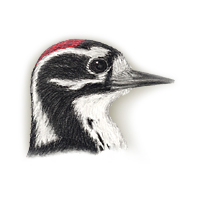 |
Nuttall's Woodpecker
Picoides nuttallii |
|
|
STANFORD LOCATIONS: Fairly common resident, breeding in a number of areas on campus, especially around oaks. One pair nested in a large century plant in the old cactus garden, another in the oak near the Faculty Club patio. |
 |
Location |
Type |
Mating System |
Parental Care |
2ndary Diet |
Strategy |
|
|
|
|
I: 14 DAYS ALTRICIAL |
|
|
|
2.5 feet - 60 feet |
|
(3-6) MONOG |
MF |
|
|
| BREEDING: | Oak woodland, chaparral, riparian (esp willow-cottonwood) woodland; often foothill canyons. ? broods. |
| DISPLAYS: | Mostly territorial: head bobbing and turning, crest raising, bill directing and raising, wing spreading and aerial displays. |
| NEST: | Usu in dead riparian decid tree. Unlined. Excavation ca. 13 days, not reused. |
| EGGS: | White. 0.9" (22 mm). |
| DIET: | Insects (80%); also few acorns, sap, occ grain. Nuthatch style of gleaning from underside of limbs |
| CONSERVATION: | Winter resident. |
| NOTES: | Pairs remain on year-round territories. Male performs most of incubation including all nocturnal incubation and brooding. Preferentially forage on oaks; females forage on smaller branches and twigs more frequently than do males. Occ hybridizes with Ladder-backed and Downy, with which it is especially territorial. Breeding biology similar to that of Ladderback. |
| ESSAYS: | Island Biogeography; Nonvocal Sounds; Feet; Hybridization; Interspecific Territoriality; Who Incubates? |
| REFERENCES: | Jenkins, 1979; Miller and Bock, 1972. |
| Help | Abbreviations | Species-Alphabetical | Species-Taxonomic | Essays-Alphabetical | |
| Except for Stanford Locations, the material in this species treatment is taken, with permission, from The Birder's Handbook (Paul Ehrlich, David Dobkin, & Darryl Wheye, Simon & Schuster, NY. 1988). | |||||